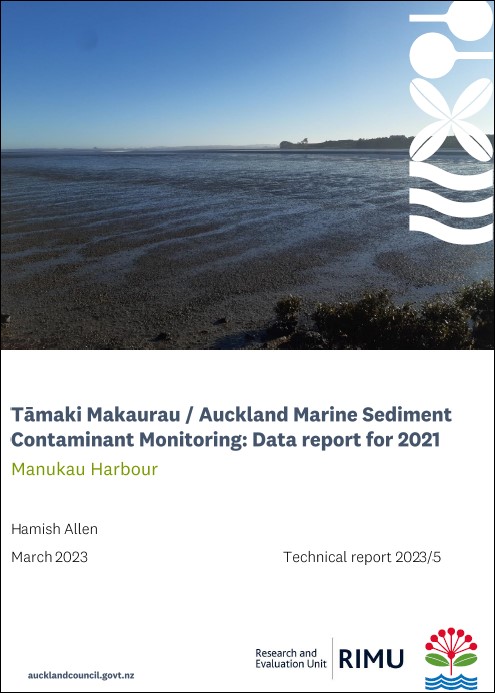Tāmaki Makaurau / Auckland marine sediment contaminant monitoring data report 2021. Manukau Harbour
Author:
Hamish AllenSource:
Auckland Council Research and Evaluation Unit, RIMUPublication date:
2023Topics:
EnvironmentExecutive summary
Contaminants such as copper, lead, zinc, arsenic, and mercury, can accumulate in the sediments of our harbours, estuaries, and beaches. These metals originate from a range of different activities and land uses including vehicle tyre and brake wear, industrial discharges, and the breakdown of some building materials. When it rains, these pollutants are washed into our stormwater networks and waterways, ending up in our marine environment. The build-up of these contaminants can affect ecological health, by reducing the abundance and/or diversity of animals living in the sediment. This can have harmful effects on the natural functioning of these ecosystems and result in degraded communities that are dominated by the remaining few species that are tolerant of higher contaminant levels. Understanding the distribution and level of chemical contaminants in marine sediments provides a useful marker of land use impacts on aquatic receiving environments and ecosystem health.
This report describes the monitoring undertaken in November 2021 for Auckland Council’s Regional Sediment Contaminant Monitoring Programme (RSCMP), with all sites located in the Manukau Harbour.
The report provides:
- an overview of the RSCMP monitoring programme
- description of the sampling undertaken in 2021
- the sediment contaminant (metals) and particle size distribution (PSD) results obtained for the 2021 samples
- a summary of contaminant (metals) state and changes over time in state
- quality assurance (QA) assessments undertaken to verify the data were acceptable for the purposes of the RSCMP.
Sediments from 27 sites in the Manukau Harbour were sampled for contaminant analysis. Samples used for sediment chemistry analysis were processed and analysed for the following metals: copper (Cu), lead (Pb), zinc (Zn), arsenic (As), and mercury (Hg). Total recoverable metals, on the <500 µm fraction, were analysed. One composite sample from each site was also analysed for particle size distribution (PSD).
The quality assurance data analysis indicated that the total recoverable metals’ data were of adequate quality, with the Certified Reference Material (CRM) and Bulk Reference Sediment (BRS) data being generally acceptable. Despite some CRM and BRS samples giving a small number of results that rated as a ‘fail’ or ‘note’ on some QA acceptance criteria (mainly in relation to temporal stability), indicating that some values were slightly outside the ‘pass’ guidelines, overall, the metals and particle size distribution data obtained in 2021 are considered suitable for use in the RSCMP.
Contaminant state (metals) are compared with Australian and New Zealand Guidelines for fresh and marine water quality (ANZG) and Auckland Council Environmental Response Criteria (ERC). The results showed a spatial pattern consistent with previous monitoring, with largely low levels of contamination (ERC-green status) at the majority of sites across the Manukau Harbour. Two sites located at the head of the harbour in the Māngere Inlet (Harania and Anns Creek) showed moderate levels of zinc contamination (ERC-amber status). These sites have shown elevated levels of metals (most commonly zinc), since monitoring began in 1998 (Anns Creek), and 2005 (Harania). Encouragingly, no sites in the harbour recorded contamination levels in the ERC-red status.
In general, ERC contaminant status (for metals Cu, Pb and Zn) has remained relatively stable over time at sites in the Manukau Harbour. Changes in state did occur at Anns Creek, dropping from Zn levels in the ERC-red status to the ERC-amber status, and Waimāhia Central, dropping from Zn levels in the ERC-amber status to the ERC-green status. It is possible that the change in state at these sites is attributable to previous issues with Zn analysis during the last samplings at these sites in 2018 (Anns Creek), and 2019 (Waimāhia Central), rather than actual decreasing concentrations. Changes in state refer to a change relative to ERC threshold levels only. More sensitive trend analysis (statistical analysis of the monitoring data to obtain the magnitude and direction of change over time) can be found in Mills and Allen, 2021.
Auckland Council technical report, TR2023/5
March 2023
See also
Tāmaki Makaurau / Auckland marine sediment contaminants. Summary of TR2023/5
